| ID |
Date |
Author |
Subject |
|
51
|
Wed Jul 20 16:07:58 2016 |
A.Tarifeņo, J.L. Tain, J. Agramunt, A. Tolosa, ... | 252Cf |
19/Jul/2016
Scanning of the efficiency as a function of longitudinal position
File:160719_BRIKEN_252Cf_XXmm_*.dlt
Online:160719_BRIKEN_252Cf_XXmm.root
Run: 011-025
Distances: -275,-175,-125,-75,-50.-25,+25,+50,+75,+125,+175,+225,+275,+375mm |
|
50
|
Wed Jul 20 12:00:15 2016 |
J.L. Tain, J. Agramunt, A. Tarifeņo, A. Tolosa, ... | 252Cf |
Measurement with the source at the center
Listmode: 160719_BRIKEN_252Cf_009.dlt
Online: 160719_BRIKEN_252Cf.root
BRIKEN: 1.03697E7
Pulser: 5985
Rate: 17326 n/s |
|
49
|
Wed Jul 20 11:49:00 2016 |
J.L. Tain, J. Agramunt, R. Baeturia, A. Tarifeņo, A. Tolosa, ... | Background |
18/07/2016
First background measurement overnight.
START: 23:37
File: 160718_FullBrikenFirstData_bkg_*.dlt Run:003-006
Online: 160718_FullBrikenFirstData_bkg.root
Attached screenshots of raw data for every digitizer.
The problem of some of the PA is visible in the background
spectra.
In addition one can see in some of the channels signals
distributed over all the region up to the pulser and beyond.
This we found to be related to a too low threshold
but can be eliminated with a better adjustment. |
| Attachment 1: 160718_FullBrikenFirstData_bkg.zip
|
|
48
|
Wed Jul 20 11:40:00 2016 |
J.L. Tain, J. Agramunt, R. Baeturia, A. Tarifeņo, A. Tolosa, ... | 252Cf |
First measurement with full 140 tube version
of the BRIKEN neutron detector
Directory: /data/160716Test01/
Configuration: 160718Conf_BrikenFull.xlsx
File: 160718_FullBrikenFirstData_252Cf_002.dlt
Online: 160718_FullBrikenFirstData_252Cf.root
All tubes and channels working!
Sample of screenshots included. |
| Attachment 1: RIKEN-252Cf-V1A1.png
|
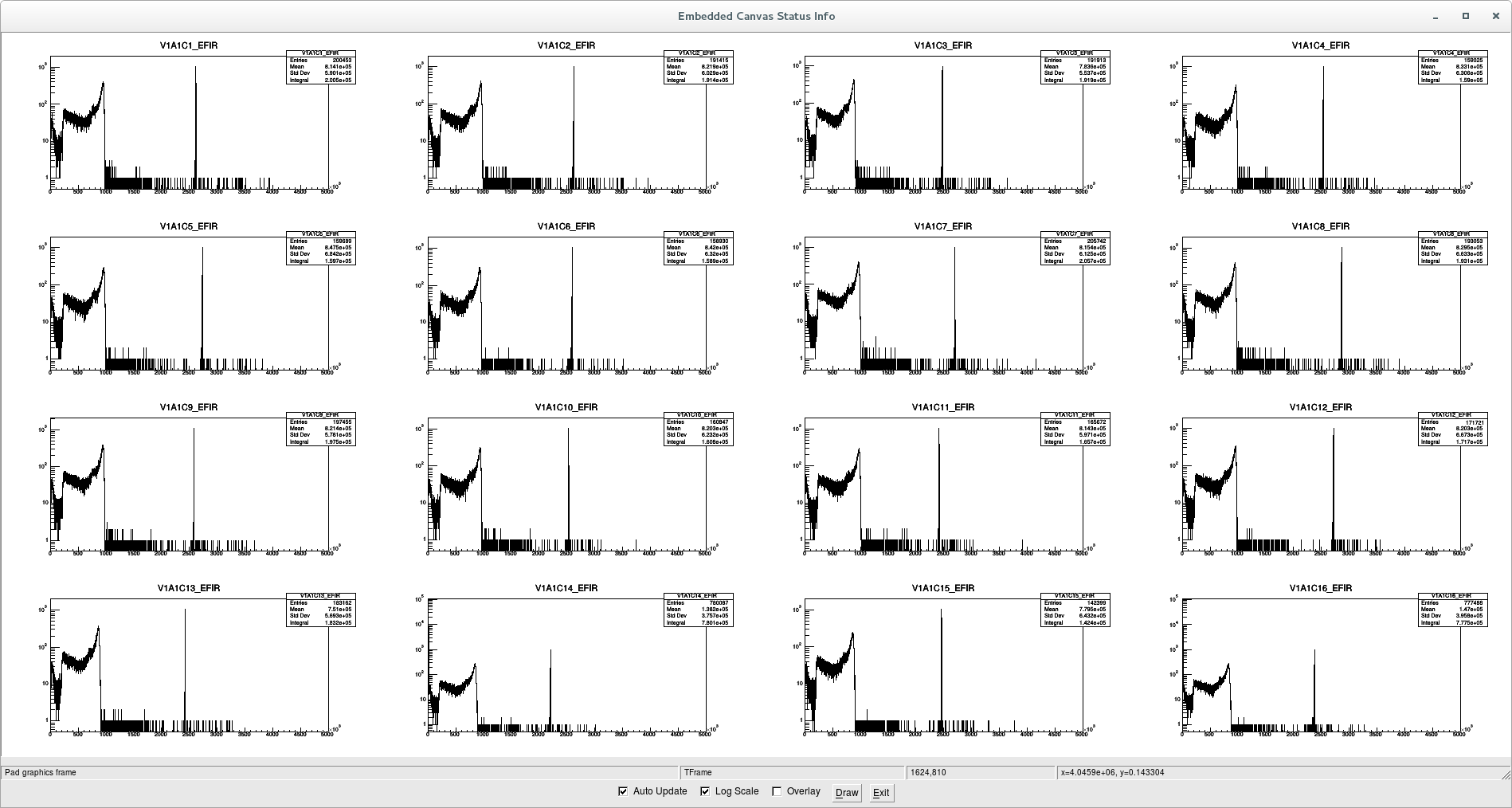
|
| Attachment 2: UPC-252Cf-V1A3.png
|
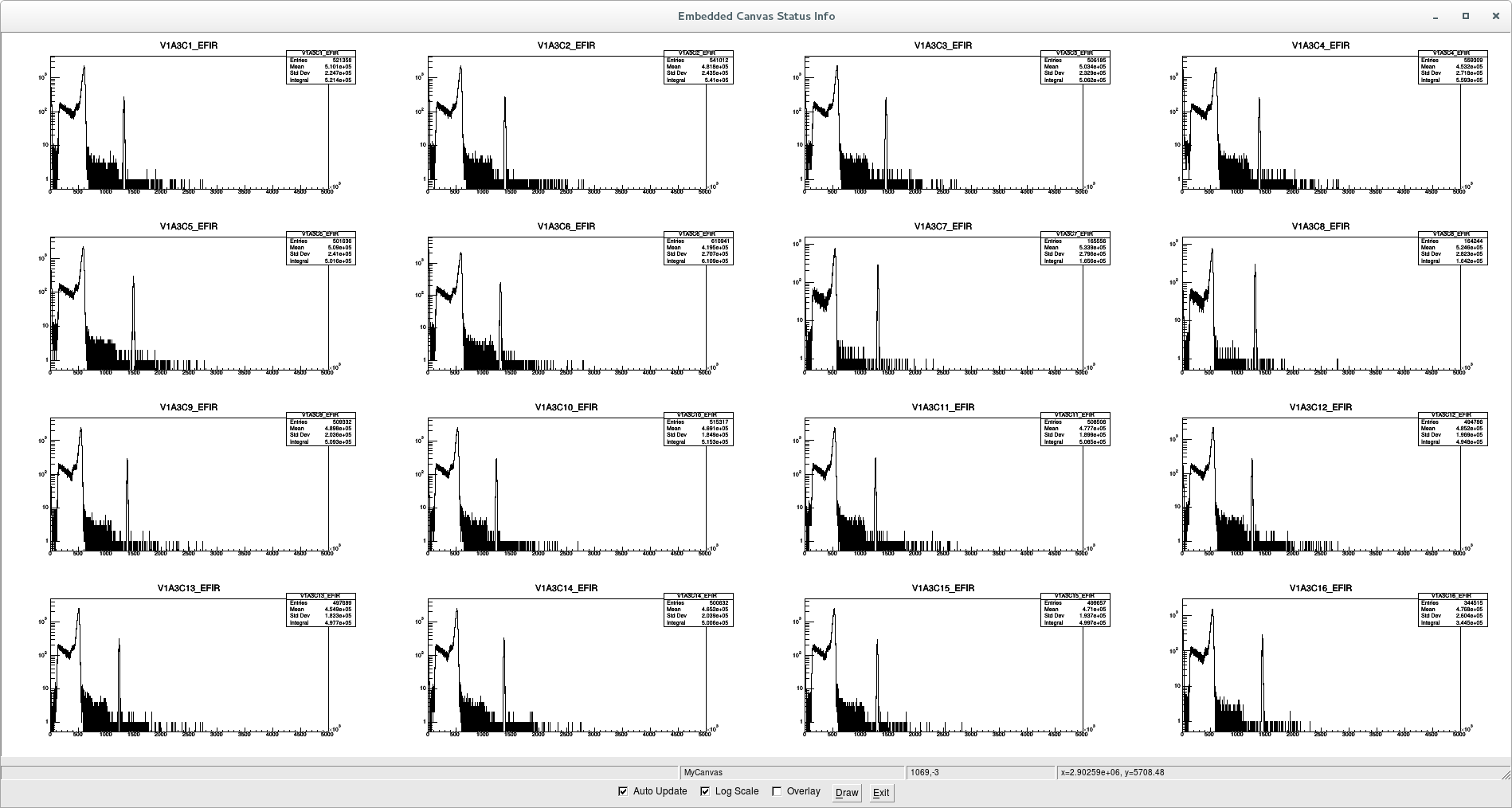
|
| Attachment 3: ORNL1-252Cf-V1A5.png
|

|
| Attachment 4: ORNL2-252Cf-V1A6.png
|

|
|
47
|
Wed Jul 20 11:16:18 2016 |
J.L. Tain | Electronics |
Pulser settings
We use two pulsers, Pulser1 for RIKEN, ORNL1 and ORNL2 tubes (7 PA)
and Pulser2 for UPC tubes due to the different gains (3 PA)
10HzClock->G&DG->Pulser->LinearFI/FO
Pulser1: BNC BH-1: trise=1us, tfall=1ms, amp=670mV(scope), NEG
Pulser2: BNC PB-5: tfall=1ms, amp=0.180mV(setting), 90mV(scope), NEG
Later on we found out that Pulser1 is compatible also for
the CLOVER detectors (8PA). This will require an additional LinearFI/FO |
|
46
|
Wed Jul 20 08:58:13 2016 |
J.L. Tain, I.Dillman, R. Caballero, J. Agramunt, A. Tarifeņo, A. Tolosa, ... | Electronics |
Distribution of connections of tubes in preamplifiers and digitizers
Because of the need to use 10 PAs instead of 9 PAs we had to redistribute
the signal connections. Now:
PA1(RIKEN), PA2(RIKEN), PA3(UPC), PA4(UPC), PA5(UPC) -> V1A1-V1A4
PA6(ORNL1) -> V1A5
PA7(ORNL2) -> V1A6
PA8(ORNL2) -> V2A1,V2A2
PA9(ORNL2) -> V2A3,V2A4
PA10(ORNL2) -> V2A5,V2A6
So V1A1 to V1A4 contain now signals from 2 PAs.
We also redistributed the tubes within the PAs
We also changed the numbering or RIKEN Tubes. Tube 1 to 12 are now
those on the AIDA side (PA1 attached to the PE block)
A figure showing the distribution of tubes an numbering is included.
Tube 1 is behind tube 19 and so forth.
Attached also is an excel file with tube-channel distribution |
| Attachment 1: TubeDistribution-new.xlsx
|
| Attachment 2: TubeDistribution-new.pdf
|

|
|
45
|
Tue Jul 19 13:47:55 2016 |
A. Tarifeņo-Saldivia | Neutron efficiency - Scanning on Z preliminary result |
We have carried out a scanning of the neutron efficiency with respect to the position along the Z-axis (AIDA and BEAM hole) of a 252Cf neutron source. A preliminary analysis is presented based on data from the online. A plot with the comparison of the simulations and experimental data is attached. The experimental results are in good agreement with the GEANT4 simulations of the studies for design of the neutron detector. The simulations for the design of the hybrid mode were calculated using 148 3He counters. The version of the hybrid detector assembled during the current campaign (July-2016) is using 140 3He counters. The missing counters correspond to tubes located on the outer part of PE, thus the effect of these counters on the total neutron efficiency is minimal.
|
| Attachment 1: Preliminar_Zscaning_BRIKEN_PremLabel_vsmall.png
|
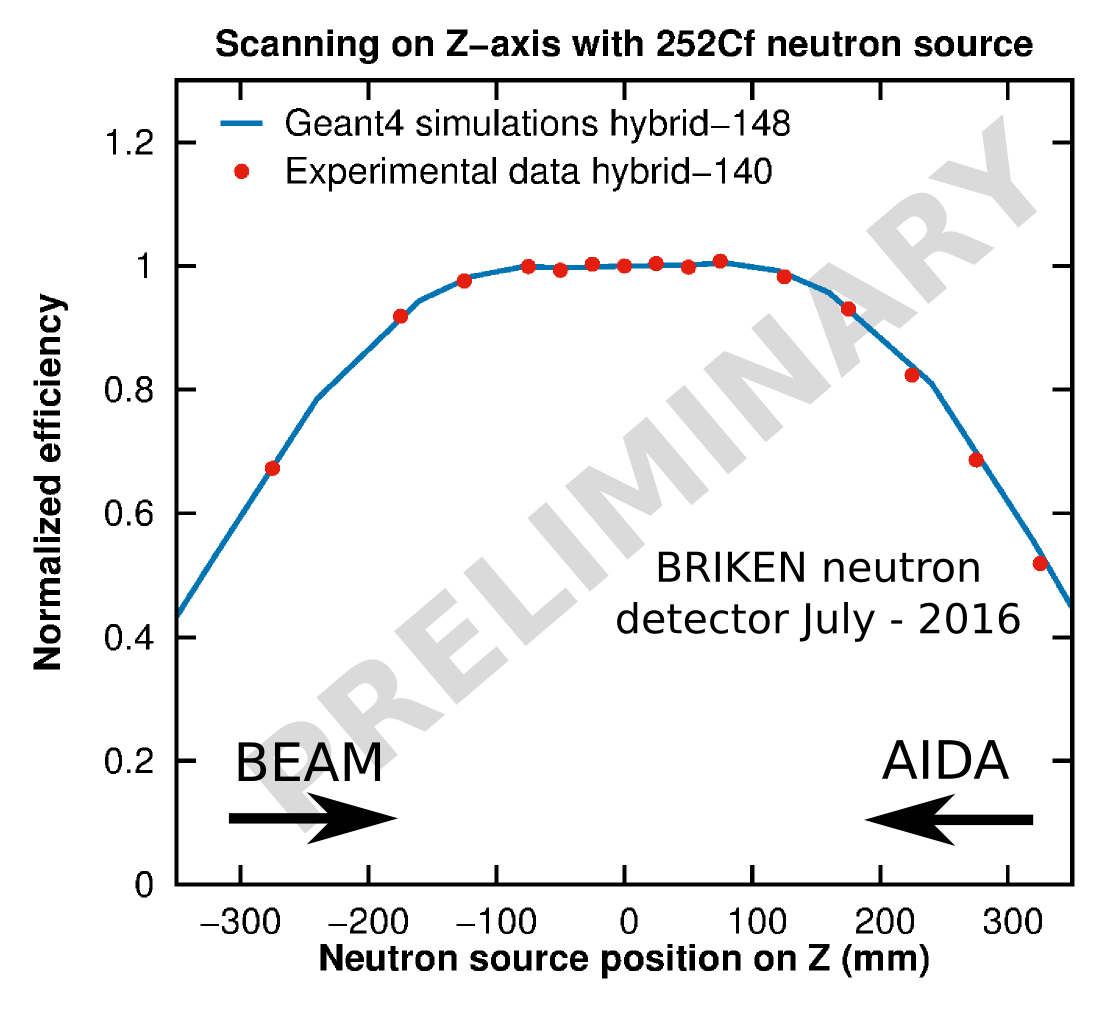
|
|
44
|
Tue Jul 19 11:54:03 2016 |
JL Tain A Tolosa R. Caballero A. Tarifeņo J. Agramunt | Photos of the AIDA insertion hole with the 3He tubes |
RIKEN tubes on the AIDA side with the SHV right angle connector will protrude
by ~95mm in the HYBRID configuration (with CLOVERS).
In the current AIDA DSSD configuration there are six detectors occupying 45-50mm
at a distance to center of the stack from the black plastic support of ~430mm.
The hole for the CLOVER is 110mm. The center of the hole is at 375mm from the
PE end.
This means that the center of the current stack is only ~15mm beyond the PE
in the CLOVER hole, so 1 or 2 of the DSSD will be partially shadowed
from the CLOVER detectors.
(This do not represent any problem from the neutron detector point of view) |
| Attachment 1: DSC_2520.JPG
|

|
| Attachment 2: DSC_2517.JPG
|
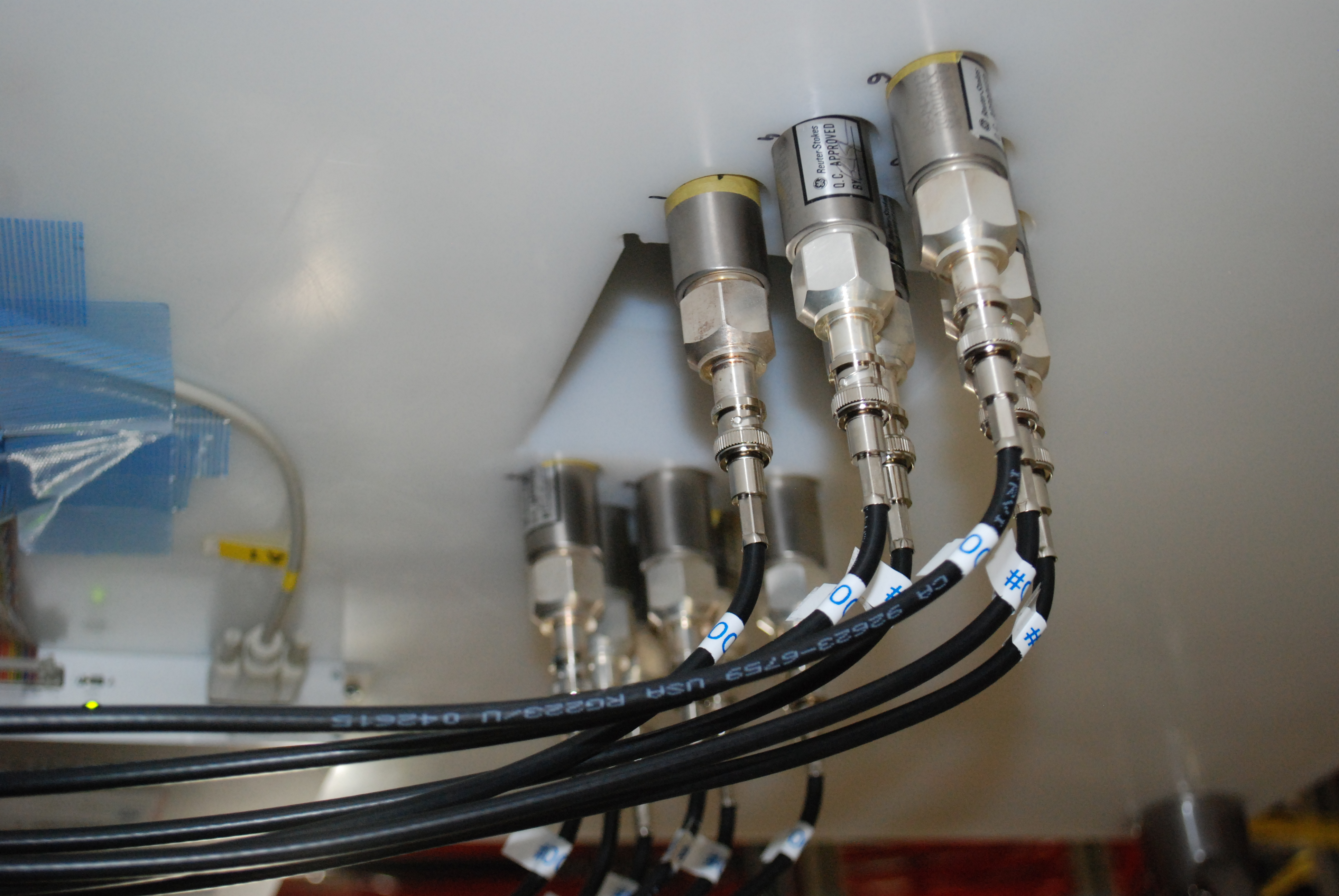
|
| Attachment 3: DSC_2515.JPG
|

|
|
43
|
Tue Jul 19 04:34:57 2016 |
JL Tain A Tolosa R. Caballero A. Tarifeņo J. Agramunt | Photos of the electronics |
Racks, crates, rear part of the preamps and matrix with all tubes. |
| Attachment 1: DSC_0034.JPG
|

|
| Attachment 2: DSC_0022.JPG
|
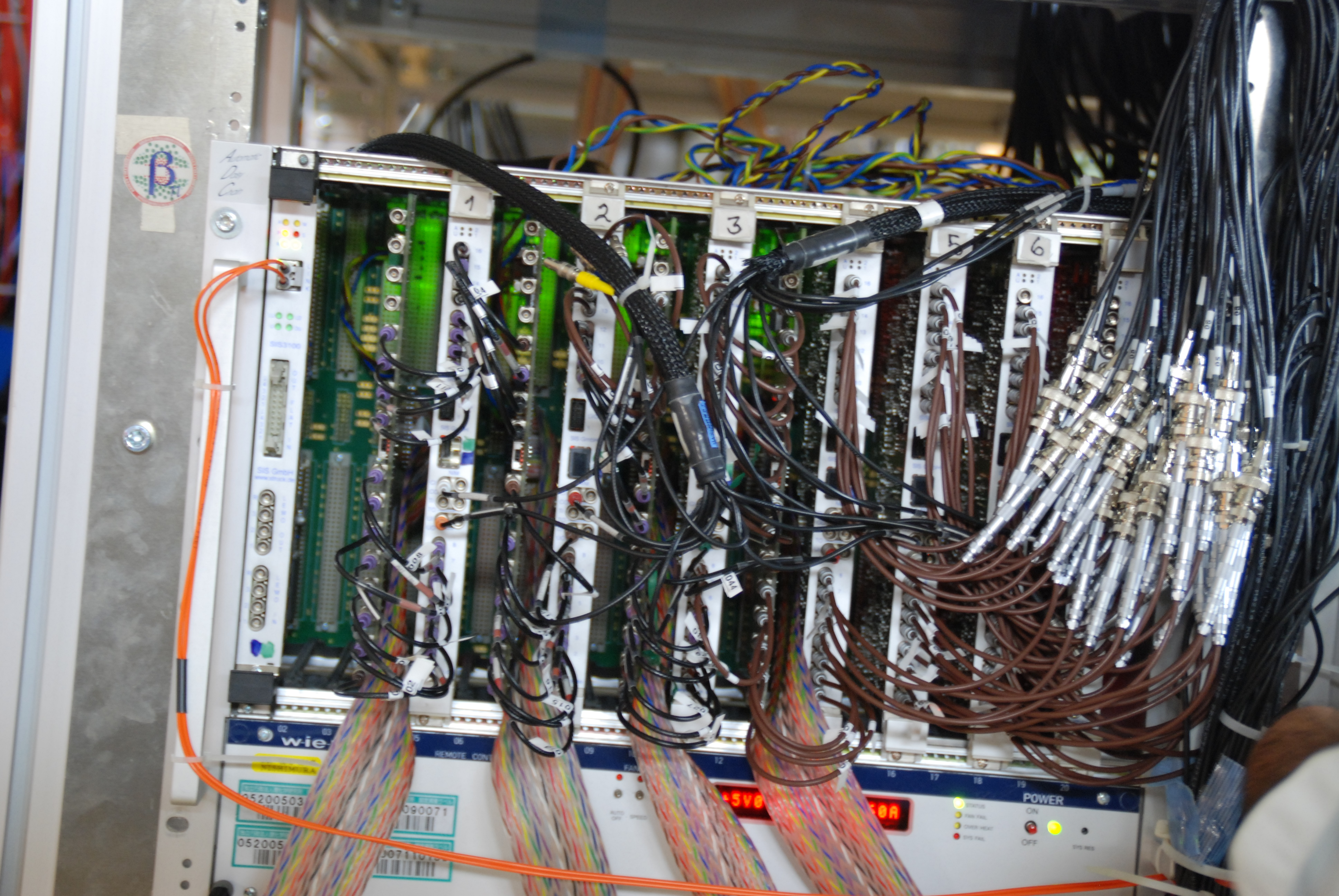
|
| Attachment 3: DSC_0016.JPG
|

|
| Attachment 4: DSC_2483.JPG
|

|
| Attachment 5: DSC_2497.JPG
|

|
| Attachment 6: DSC_2511.JPG
|
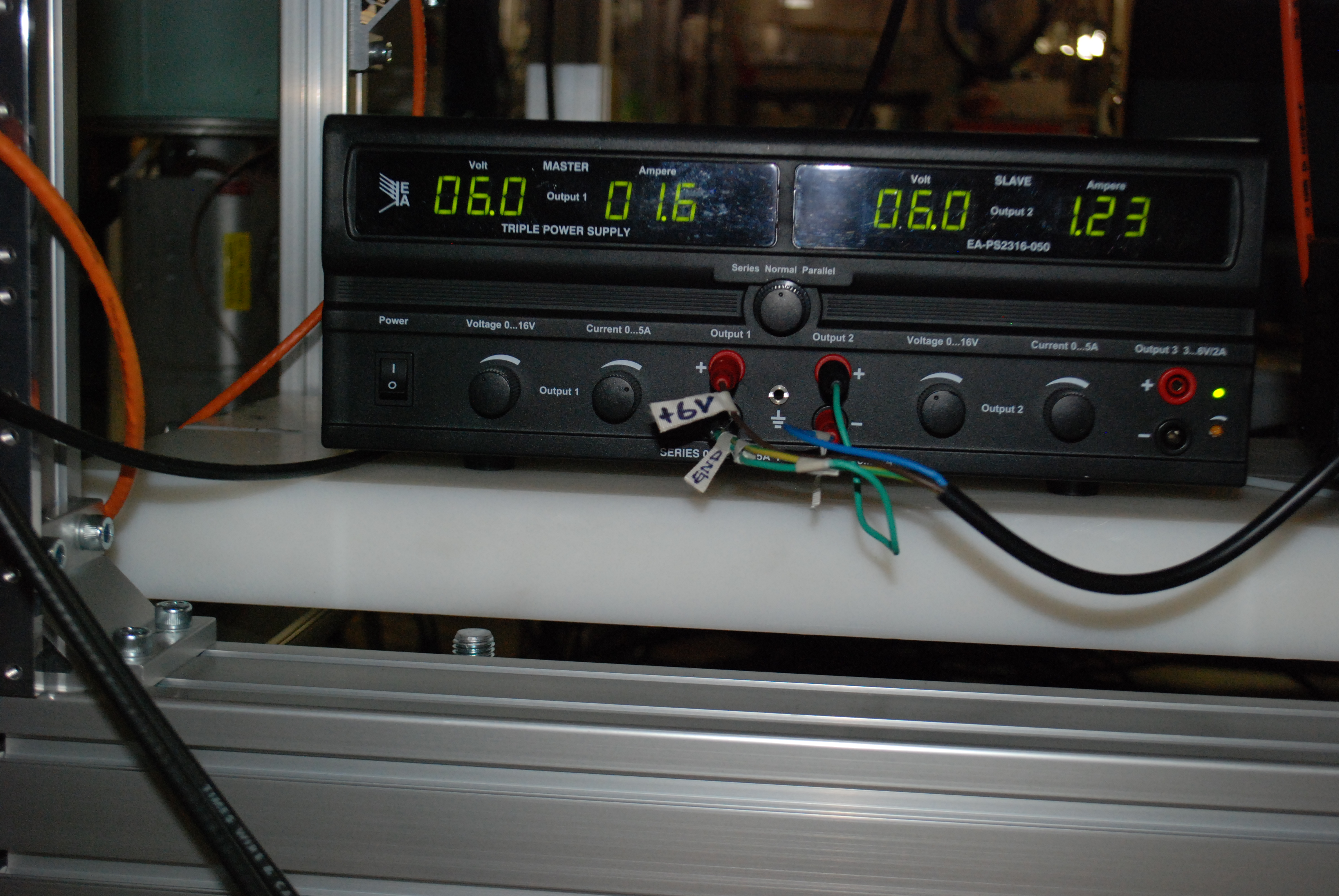
|
| Attachment 7: DSC_2513.JPG
|

|
| Attachment 8: DSC_2514.JPG
|

|
| Attachment 9: DSC_2526.JPG
|

|
|
42
|
Tue Jul 19 04:09:32 2016 |
JL Tain A Tolosa R. Caballero A. Tarifeņo J. Agramunt | Last tube fit in the matrix!!! |
The photo of great moment |
| Attachment 1: DSC_2478.JPG
|

|
|
41
|
Tue Jul 19 03:19:34 2016 |
A. Tarifeņo, I. Dillman, J. Agramunt, A. Tolosa, J.L. Tain... | Electronics |
Preamplifier and signal cable testing
We check all signal cables,the flat cable connector to BNC
from ORNL/UTK and they are OK.
While checking the preamplifiers (PA) we realized that on the oscilloscope
some of the channels shown pulses without a load when HV is on.
After some checks, we come to the conclusion that is a kind of discharge
on the HV part of the preamp (which appears as positive pulse or negative pulses)
and induce pulses of opposite sign in one or mos neighbouring channels.
After systematically investigating them in the scope, we plug them in the DACQ
to record the spectra. For this we include an additional digitizer SIS3316
to connect al1 channel preamps
PA1(D):UPC:SN-0808223 -> V1A1
PA2(D):GSI:SN-1112572 -> V1A2
PA3(D):UPC:SN-0310315 -> V1A3
PA4(D):UPC:SN-0808220 -> V1A4
PA5(U):UTK: ? -> V1A5
PA6(U):UTK:SN-0808218 -> V1A6
PA7(U):UTK:SN-0713586 -> V1A7
PA8(U):UTK:SN-0808221 -> V2A1, V2A2
PA9(U):UTK:SN-0808215 -> V2A3, V2A4
PA10(U):UTK:SN-0808217 -> V2A5, V2A6
We measure first with a tube of each type connected to Ch#1 of each PA
to adjust parameters of digitizers and range
List-mode: 160717_preampCheck_000.dlt
On-line: 160717_preampCheck.root
Then we remove the tube from Ch#1 to see the effect in this channel:
List-mode: 160717_preampCheck_noTubes_001.dlt
On-line: 160717_preampCheck_noTubes.root
We attach screenshots for both as compressed files (.zip)
and the root files |
| Attachment 1: preampCheck.zip
|
| Attachment 2: noTubeCh1.zip
|
| Attachment 3: 160717_preampCheck.root
|
| Attachment 4: 160717_preampCheck_noTubes.root
|
|
40
|
Mon Jul 18 19:01:36 2016 |
J.L. Tain | 3He tubes |
Adjustment of HV and PA gain
We adjust the HV for each tube type and the gain of the preamplifier (PA) in order
to have a similar signal amplitude for the 764keV peak in all of them.
Because of the very different gain between tubes we are not able to combine in the same
PA tubes from RIKEN and UPC, thus we have to go for 10 PA instead of 9:
Settings: Preamp (type), Tube type, HV, Gain, height or 764keV pulse, pulse polarity
PA1 (D), RIKEN, 1450V, LowGain, ~400mV, POS
PA2 (D), RIKEN, 1450V, LowGain, ~400mV, POS
PA3 (D), UPC, 1550V, HighGain, ~400mV, POS
PA4 (D), UPC, 1550V, HighGain, ~400mV, POS
PA5 (U), UPC, 1550V, HighGain, ~600mV, NEG
PA6 (U), ORNL1, 1200V, LowGain, ~400mV, NEG
PA7 (U), ORNL2, 1750V, LowGain, ~400mV, NEG
PA8 (U), ORNL2, 1750V, LowGain, ~400mV, NEG
PA9 (U), ORNL2, 1750V, LowGain, ~400mV, NEG
PA10 (U), ORNL2, 1750V, LowGain, ~400mV, NEG
We need to use two different pulse generators to adjust differently the pulse height
of UPC tubes |
|
39
|
Mon Jul 18 18:40:32 2016 |
A. Tarifeņo-Saldivia and J. L. Tain | 3He tubes - Testing |
Test of individual 3He tubes
The tests were done using the ATOMKI MCA and
HV: ISEG NH204M
Preamp: Mesytec MHV-16 (Unipolar IFIC)
Amp: ORTEC671 (Gain=5x0.5,SHP=6us)
Pulser: 10Hz-Clock + TC410A G&DG + BH-1 (tr=1us,tf=1ms,amp=0.7)
Spectra measured with 1024 channels
Counting time: 100s (UPC, RIKEN and ORNL 1")
120s (ORNL 2")
Neutron source: 252Cf
PE setup: 1 inches tubes were tested on the BELEN-20 PE matrix, while for 2 inches tubes a moderator was prepared
using existing material (see attached figures).
Attached a figure with a sample spectrum for each tube type
and a compressed file with all the measured spectra in ASCII format.
All the tubes performed correctly. The neutron signal is well separated from the noise.
The RIKEN tubes have the highest gain. Gain in the UPC tubes is the lowest.
|
| Attachment 1: Histograms_testing_BRIKEN_tubes_Jul16.zip
|
| Attachment 2: Tube1_RIKEN.png
|

|
| Attachment 3: Tube25_UPC.png
|

|
| Attachment 4: Tube65_ORNL_1inch.png
|
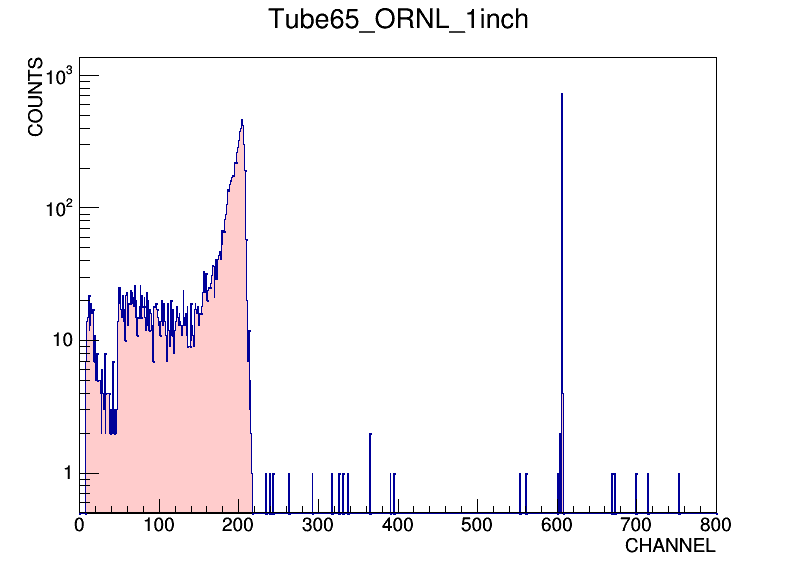
|
| Attachment 5: Tube88_ORNL_2inch.png
|
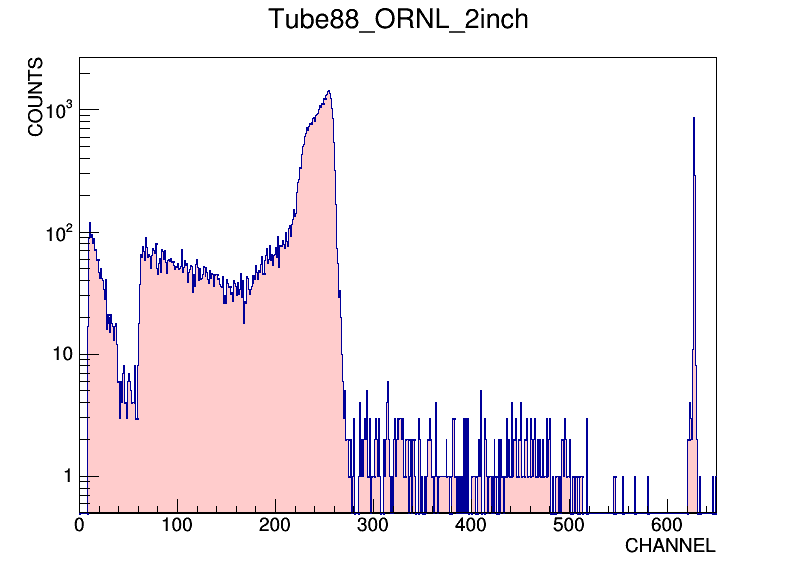
|
| Attachment 6: setup_1inch.jpeg
|
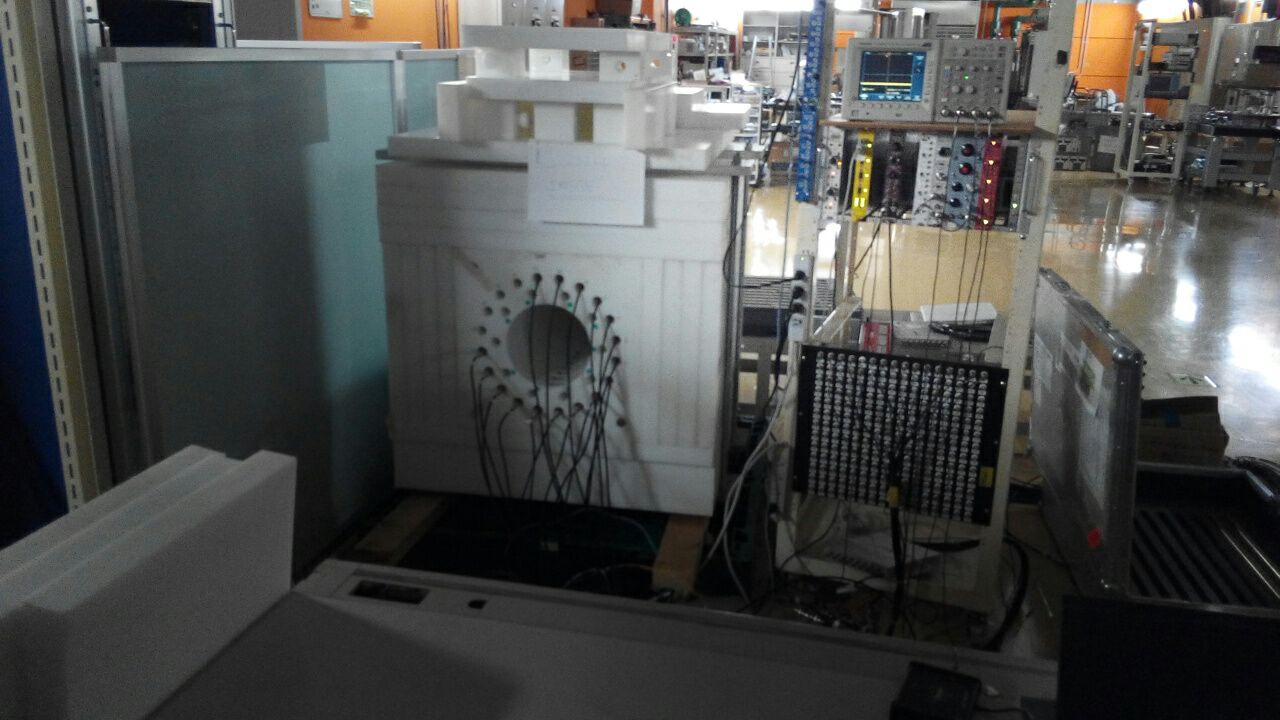
|
| Attachment 7: setup_2inch.jpeg
|
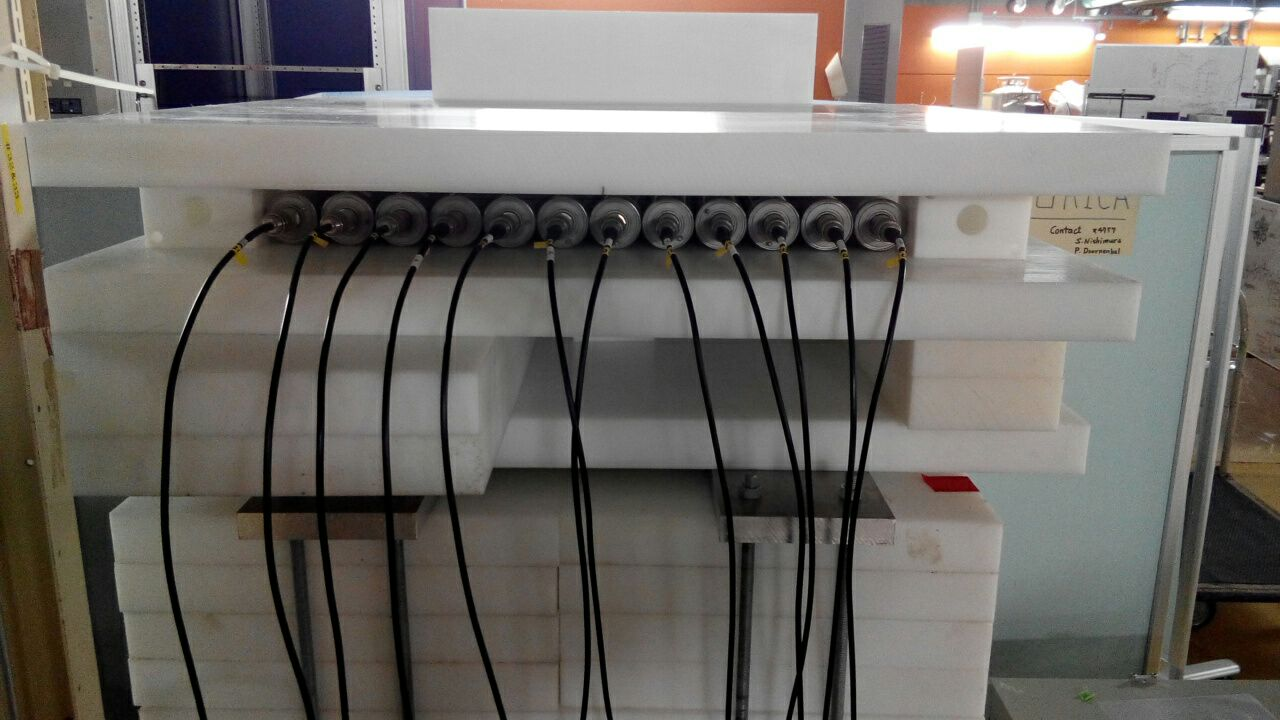
|
|
38
|
Mon Jul 18 09:32:50 2016 |
Shintaro Go | HV controls |
You can start applying HVs on the detectors using macro on the control-computer.
If you have already signed in the computer that controls mpod,
1. Type http://192.168.13.239/ to monitor the status of HV.
2. Go to the directory : /home/pixie16/DAQ_1/include and open the config file : hvmon.conf
Type IP address channel slot name voltage Current RampUp RampDn Switch On/Off/RESET
V A V/s V/s 1 / 0 / 10
------ --------------- --------- ----- ---- ------- ------- ------ ------ -------------
0 192.168.13.239 0 0 PA1 1450 0.0001 50 10 0
0 192.168.13.239 1 0 PA2 1450 0.0001 50 10 0
0 192.168.13.239 2 0 PA3 1550 0.0001 50 10 0
0 192.168.13.239 3 0 PA4 1550 0.0001 50 10 0
0 192.168.13.239 4 0 PA5 1550 0.0001 50 10 0
0 192.168.13.239 5 0 OFF 0 0.0001 50 10 10
0 192.168.13.239 6 0 OFF 0 0.0001 50 10 10
0 192.168.13.239 7 0 OFF 0 0.0001 50 10 10
0 192.168.13.239 0 1 PA6 1200 0.0001 50 10 0
0 192.168.13.239 1 1 PA7 1750 0.0001 50 10 0
0 192.168.13.239 2 1 PA8 1750 0.0001 50 10 0
0 192.168.13.239 3 1 PA9 1750 0.0001 50 10 0
0 192.168.13.239 4 1 PA10 1750 0.0001 50 10 0
0 192.168.13.239 5 1 OFF 0 0.0001 50 10 10
0 192.168.13.239 6 1 OFF 0 0.0001 50 10 10
0 192.168.13.239 7 1 OFF 0 0.0001 50 10 10
0 192.168.13.239 0 3 D40 3000 0.0001 2 5 0
0 192.168.13.239 1 3 D41 3000 0.0001 2 5 0
0 192.168.13.239 2 3 D42 3000 0.0001 2 5 0
0 192.168.13.239 3 3 D43 3000 0.0001 2 5 0
0 192.168.13.239 4 3 G70 2500 0.0001 2 5 0
0 192.168.13.239 5 3 G71 3000 0.0001 2 5 0
0 192.168.13.239 6 3 G72 2500 0.0001 2 5 0
0 192.168.13.239 7 3 G73 2500 0.0001 2 5 0
When you want to start HVs, you may have to change the last bit to be 1.
Then go to the following path /home/pixie16//DAQ_1/hv-mpod and execute the command ./hvmon (The process should start),
When you want to down HVs, you may have to change the last bit to be 1.
Sometime you may get error messages colored red on the status monitor when you down the HVs, then you have to change the config file (hvmon.conf) and set the last bit to be 10 to clear the error messages.
--------------------------------------
The IP adress of the computer is currently 192.168.13.250. The user name : pixie16, password: ask Nathan or Shintaro
For now, slot names PA should be He3 and DXX and GXX should be clovers.
You can also change the HV values by changing hvmon.conf
|
|
37
|
Fri Jul 15 11:47:31 2016 |
Nathan Brewer and Alvaro Tolosa | Preliminary Ge Calibration, Resolution and Configuration |
Today several tests (3) were done with the germanium detectors with the voltage configuration listed in the previous entry.
The tests were as follows:
Tests with 60Co+137Cs sources
1. Initial evaluation of calibration and resolution (Calibration60Co137Cs_energySignal.root)
2. Cable changes to optimize resolution for detector D4 (Calibration60Co137Cs_timingSignal.root)
Test with 152Eu
3. Final (proposed) configuration of filter parameters, voltages, and cable connections. (Calibration152Eu.root)
------------------------------------------------------------------------------------------------------------------------------------
At the time of this log the evaluation of resolution and calibration based on Eu data is to be completed.
The configuration file for the Ge is listed in FirsttestGe.xlsx .
The details of the tests can be found in the attached .pdf pictures or in the .root files.
You may notice that 2/4 of each clover count less than the other 2 and this is due to source position.
For the runs on Co and Cs It was seen that D4 had considerable tailing in channels 1 and 3 (black and green leaves, respectively) and D4 has worse resolution. Channel 3 (green) also requires a non-linear calibration. Currently only linear calibration is applied. But this is as expected from how the detectors were running before leaving Tennessee.
Therefore we decided to check if the second group of signal cables had better resolution for detector D4. The second group of cables were presumed to be timing signals and the run is labeled as such, however, the signals are similar within a few percent and this assumption may have been incorrect.
The result is listed in calibrationClovers.ods in the third tab (TimingvsEnergy).
!!!Noise in the different groups of cables should be evaluated.!!!
Based on this test the first cable from the first test in D4 was reattached and the others remain in place. The second channel saw improvement and the 3rd and 4th channels saw limited change (deemed insignificant). This bundle has been labeled 'D4 Signal' for now.
Avg. D4 Resolution for Co and Cs lines is 3.3 keV FWHM
Avg. G7 Resolution for Co and Cs lines is 2.6 keV FWHM
We estimate that these are accurate within ~10%. But this is sufficient analysis for this point and time.
Further details will be posted regarding the Eu data , at a glance the configuration is seen to be very close except for the known non-linearity in D4 and one channel from G7 which should definitely be recalibrated. Thresholds and noise levels should also be re-evaluated.
|
| Attachment 1: D4_CoCs_71516.pdf
|
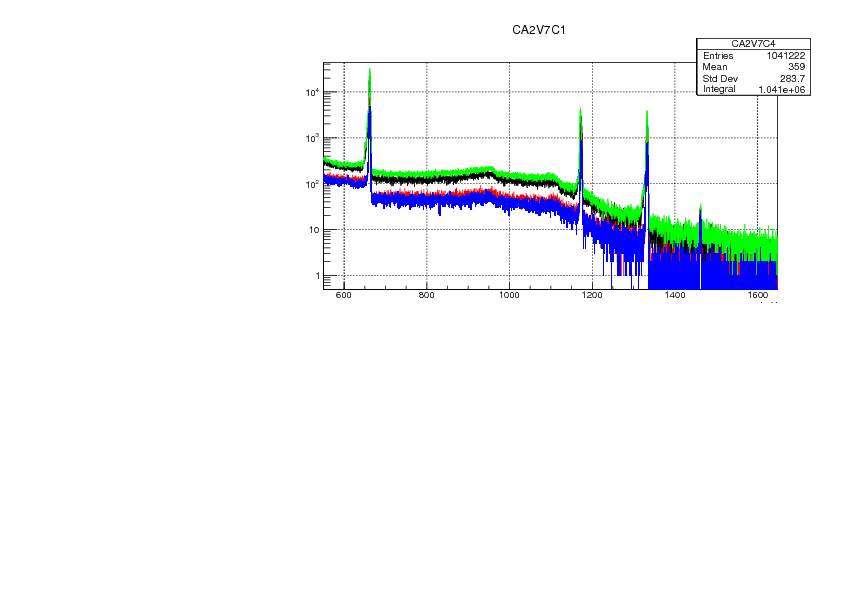
|
| Attachment 2: D4_Eu_71516.pdf
|

|
| Attachment 3: G7_CoCs_71516.pdf
|

|
| Attachment 4: G7_Eu_71516.pdf
|

|
| Attachment 5: Calibration60Co137Cs_energySignal.root
|
| Attachment 6: Calibration60Co137Cs_timingSignal.root
|
| Attachment 7: Calibration152Eu.root
|
| Attachment 8: calibrationClovers.ods
|
| Attachment 9: FirsttestGe.xlsx
|
|
36
|
Fri Jul 15 08:29:14 2016 |
Nathan Brewer, Shintaro Go | Expected Performance and Voltage Setting for Germanium |
Expected Resolution:
------------------------------
G7 should be ~2.0 keV FWHM at 600 keV for all crystals.
D4 should be as low as 1.8 and as high as 3.3 keV FWHM at 600 keV.
Configuration File: (~/DAQ_1/include/hvmon.conf)
-----------------------------------------------------------------
Type IP address channel slot name voltage Current RampUp RampDn Switch On/Off
V uA V/s V/s 1/0
------ --------------- --------- ----- ---- ------- ------- ------ ------ -------------
0 192.168.13.239 0 3 D40 3000 0.5 2 5 1
0 192.168.13.239 1 3 D41 3000 0.5 2 5 1
0 192.168.13.239 2 3 D42 3000 0.5 2 5 1
0 192.168.13.239 3 3 D43 3000 0.5 2 5 1
0 192.168.13.239 4 3 G70 2500 0.5 2 5 1
0 192.168.13.239 5 3 G71 3000 0.5 2 5 1
0 192.168.13.239 6 3 G72 2500 0.5 2 5 1
0 192.168.13.239 7 3 G73 2500 0.5 2 5 1
In all cases (Temperature Monitor, ACQ, etc.) D4 comes before G7 and in the same order.
|
|
35
|
Sat Jul 9 21:26:25 2016 |
J.L. Tain | EDACQ |
Electronics and DACQ for July 2016 assembly: hardware and connections |
| Attachment 1: EDACQ-July2016.pdf
|



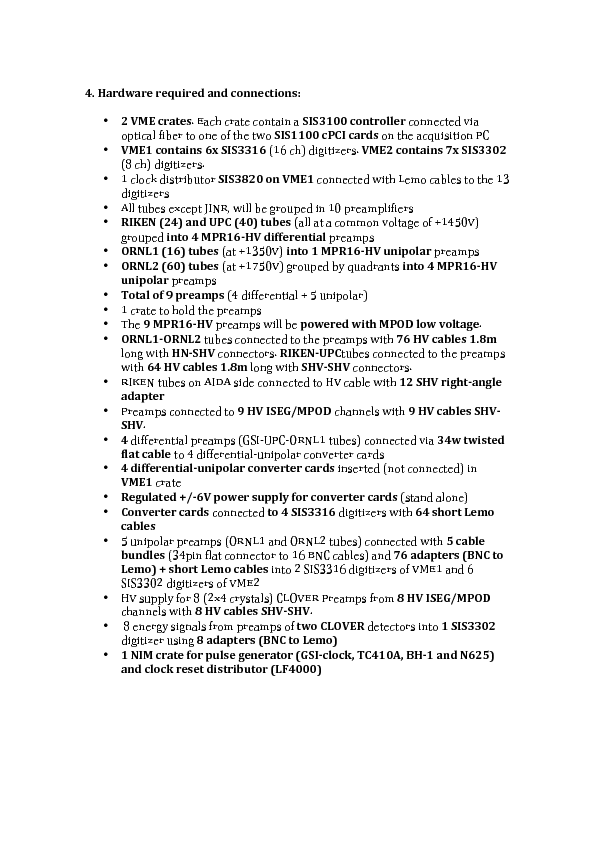


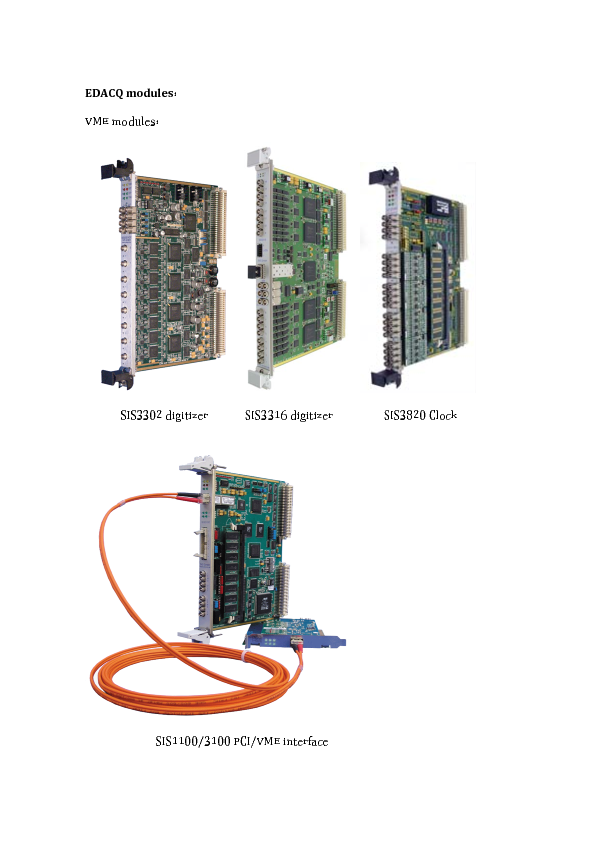

|
|
34
|
Sat Jul 9 21:21:38 2016 |
J.L. Tain | 3He tubes |
Tube distribution in the moderator, pre-amplifiers and digitizers |
| Attachment 1: TubeDistribution.pdf
|


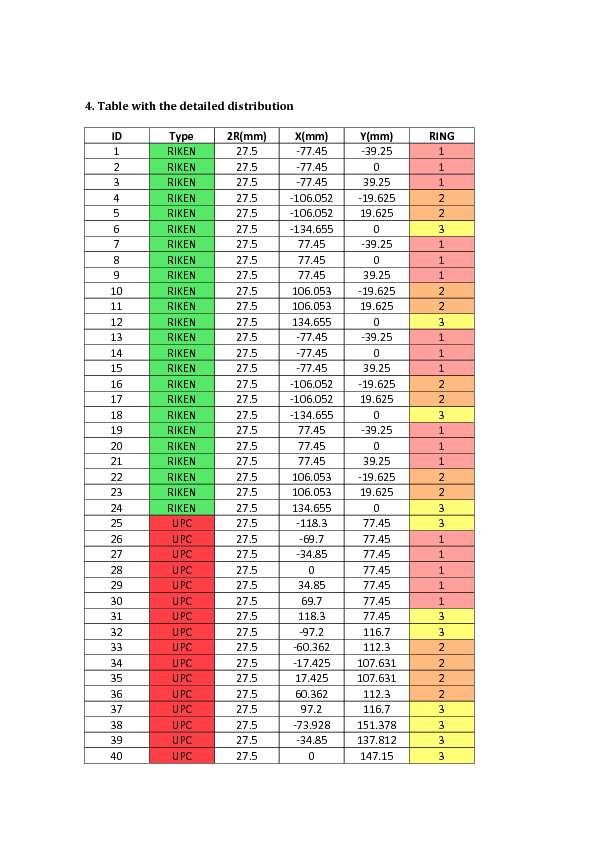
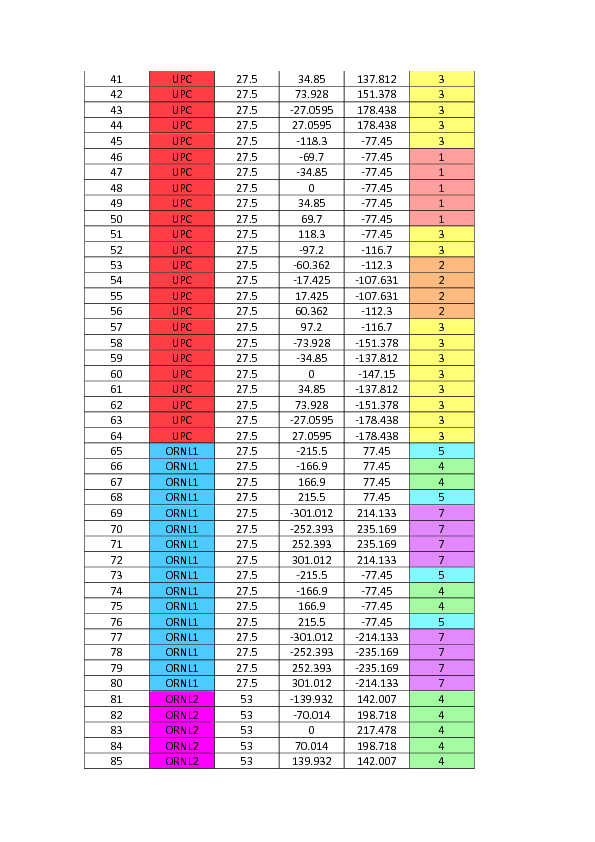



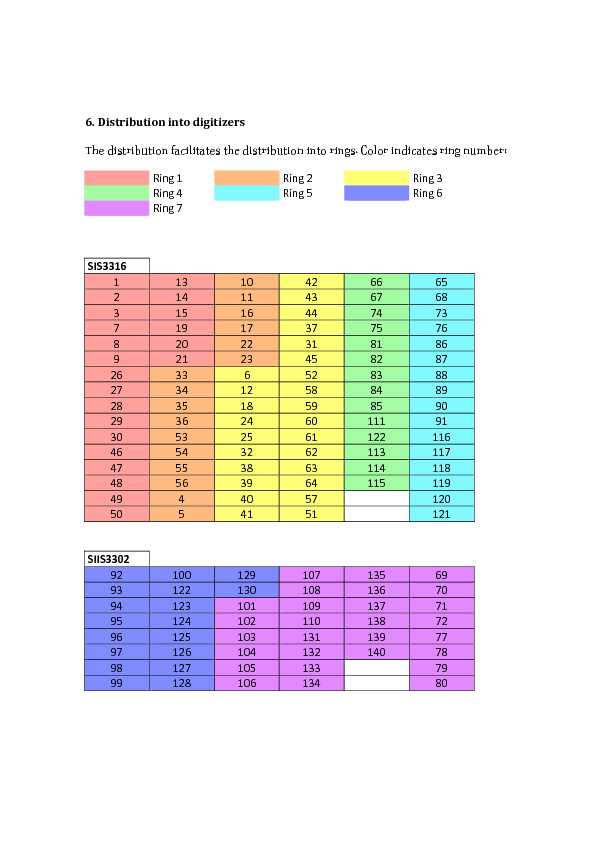
|
| Attachment 2: TubeDistribution.xlsx
|
|
33
|
Sat Jul 9 21:14:12 2016 |
J.L. Tain | 3He tubes |
Drawings and specs of 3He tubes |
| Attachment 1: He3_GE_30cm-RIKEN.pdf
|


|
| Attachment 2: 1inch3He-ORNL.pdf
|
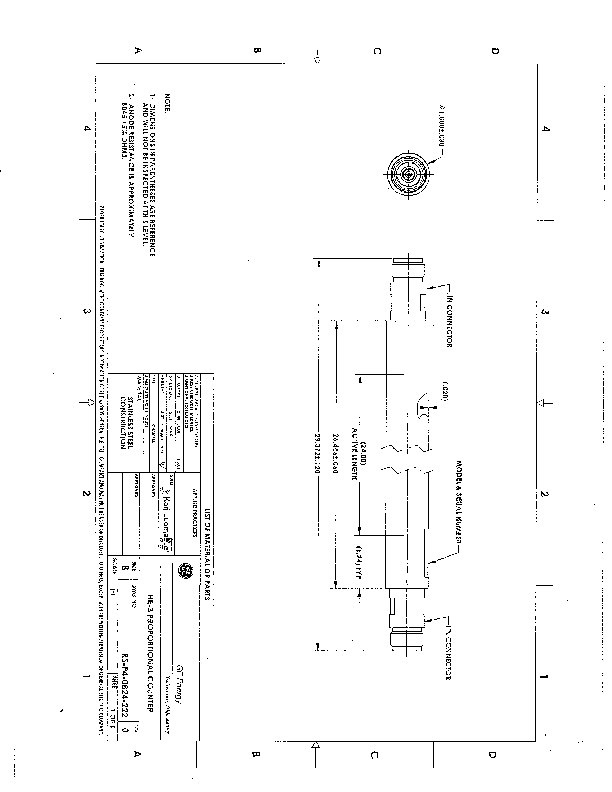

|
| Attachment 3: 2inch3He_ORNL.pdf
|
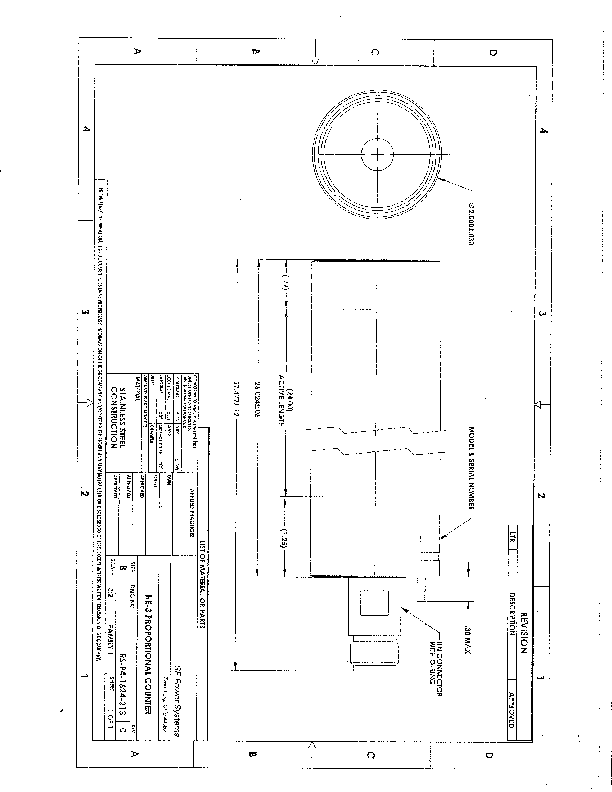
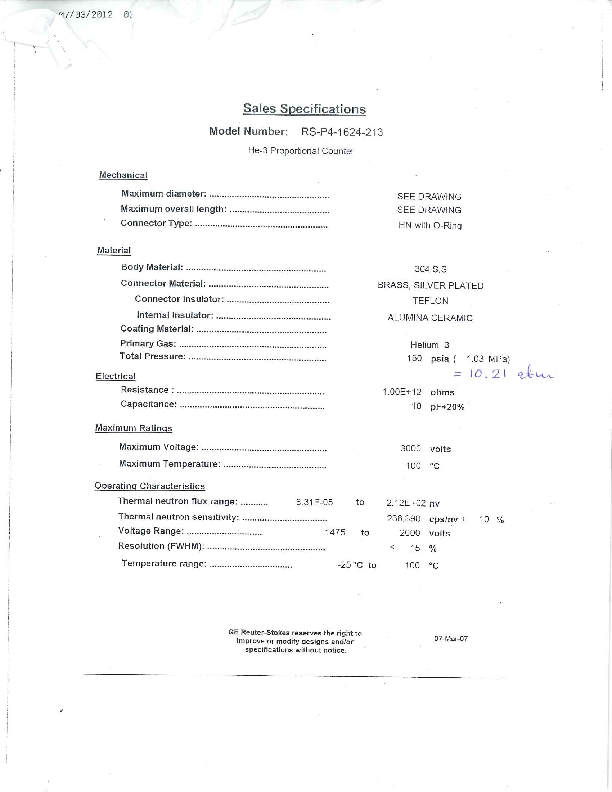
|
| Attachment 4: He3-252248-UPC-GSI.pdf
|



|
|
32
|
Sat Jul 9 21:08:08 2016 |
J.L. Tain | Neutron moderator |
Drawings of the polyethylene neutron moderator and table assembly |
| Attachment 1: Moderator-Table.pdf
|
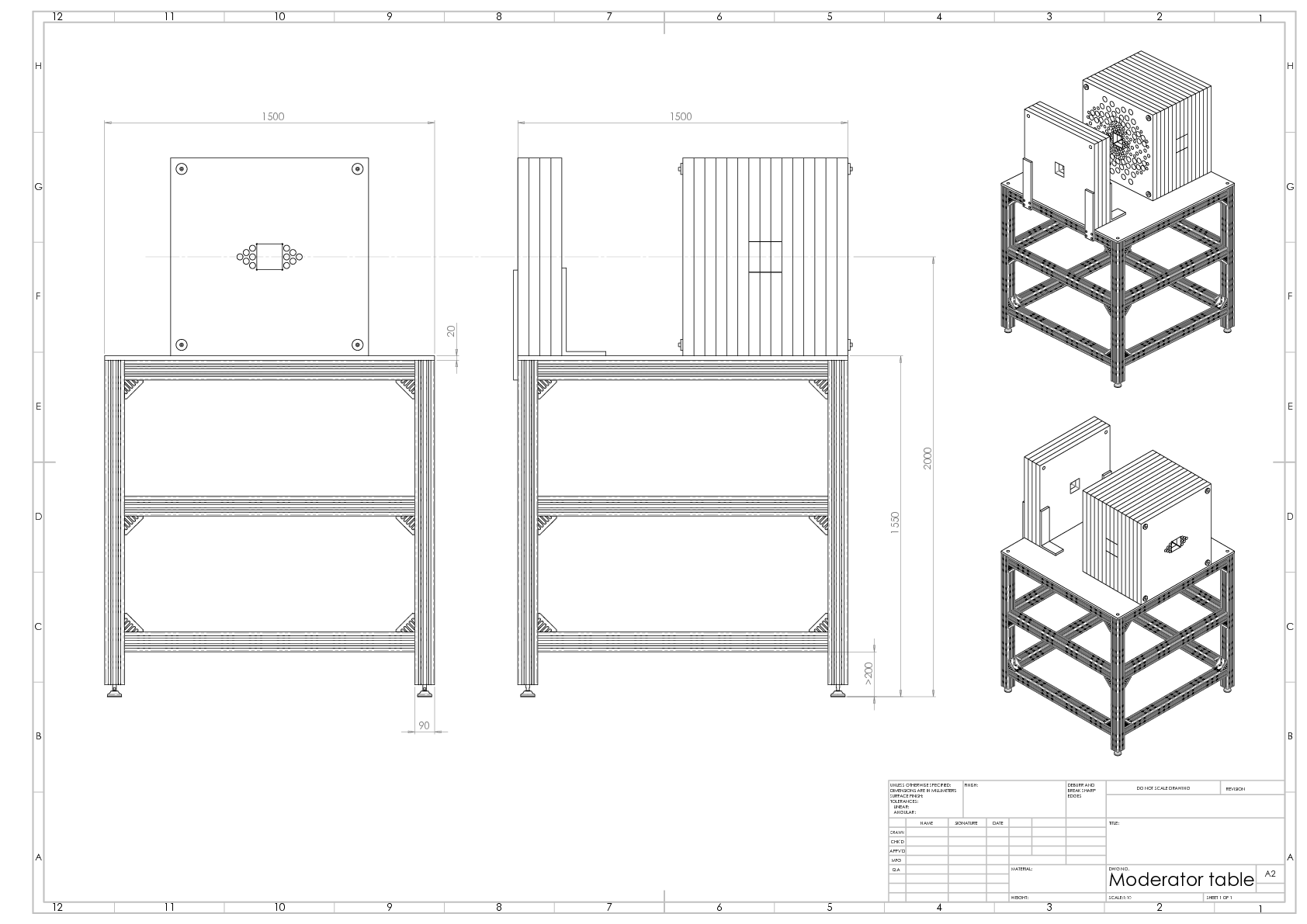
|
| Attachment 2: Table.pdf
|



|
| Attachment 3: Moderator-Shielding.pdf
|

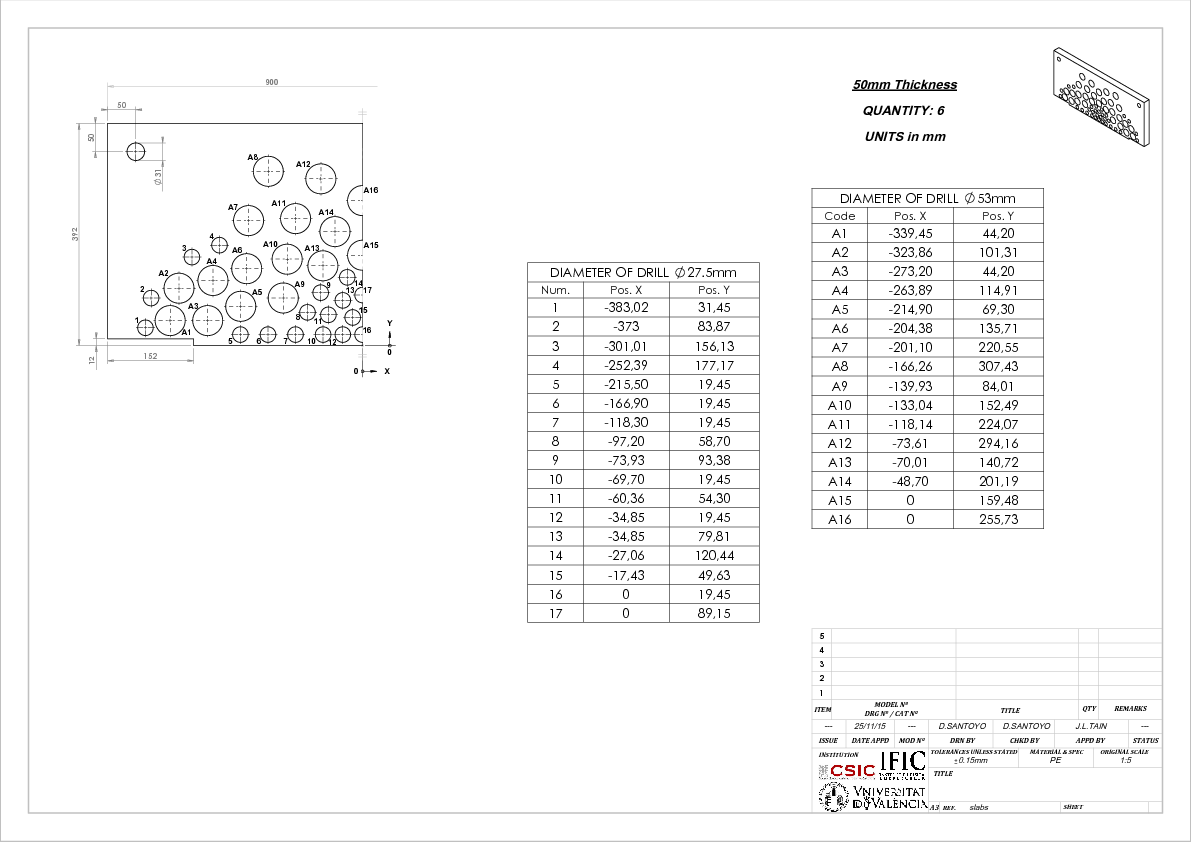
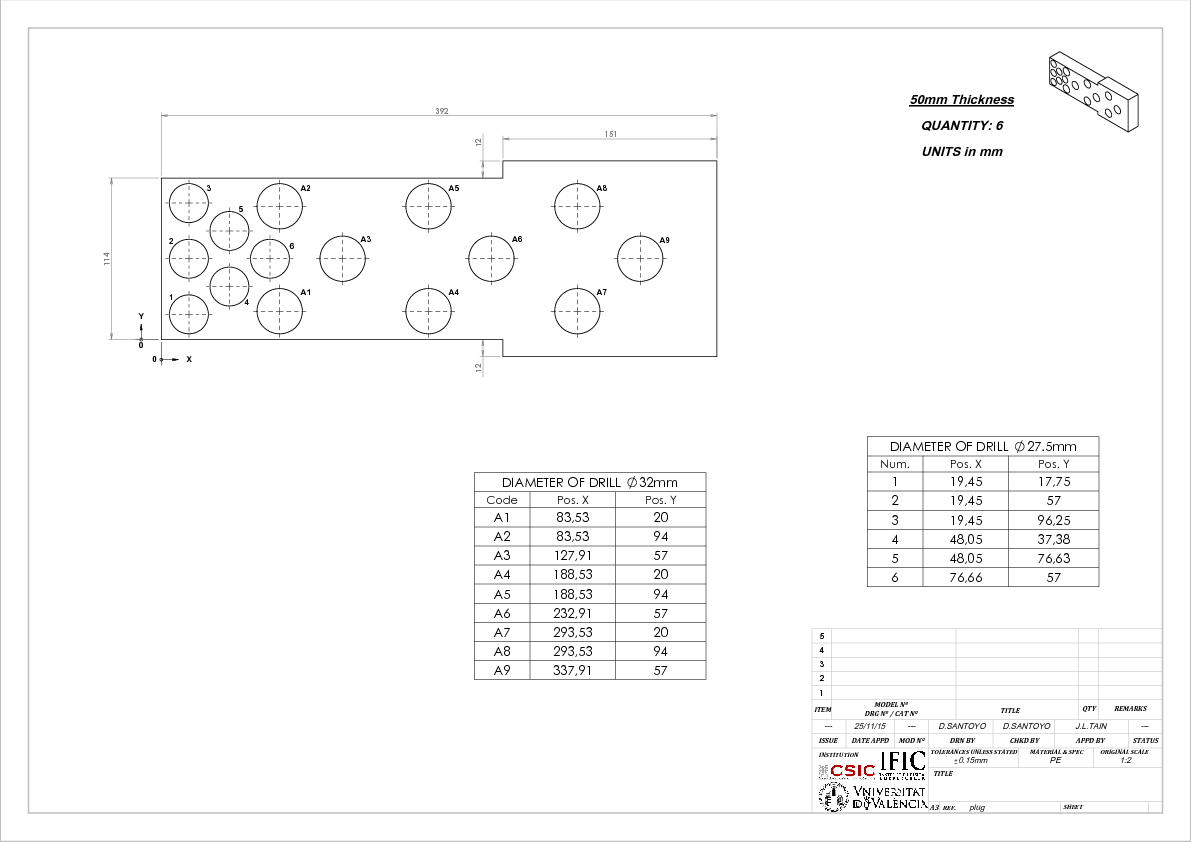
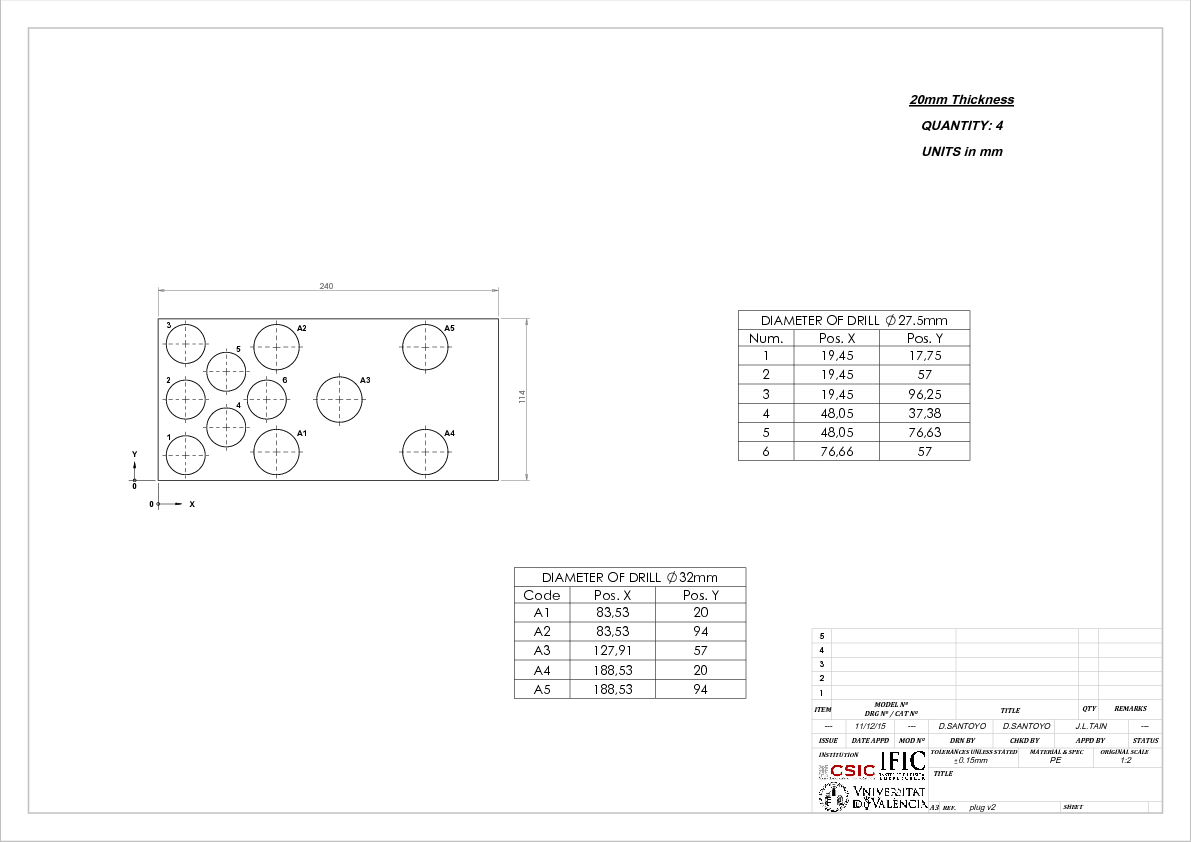
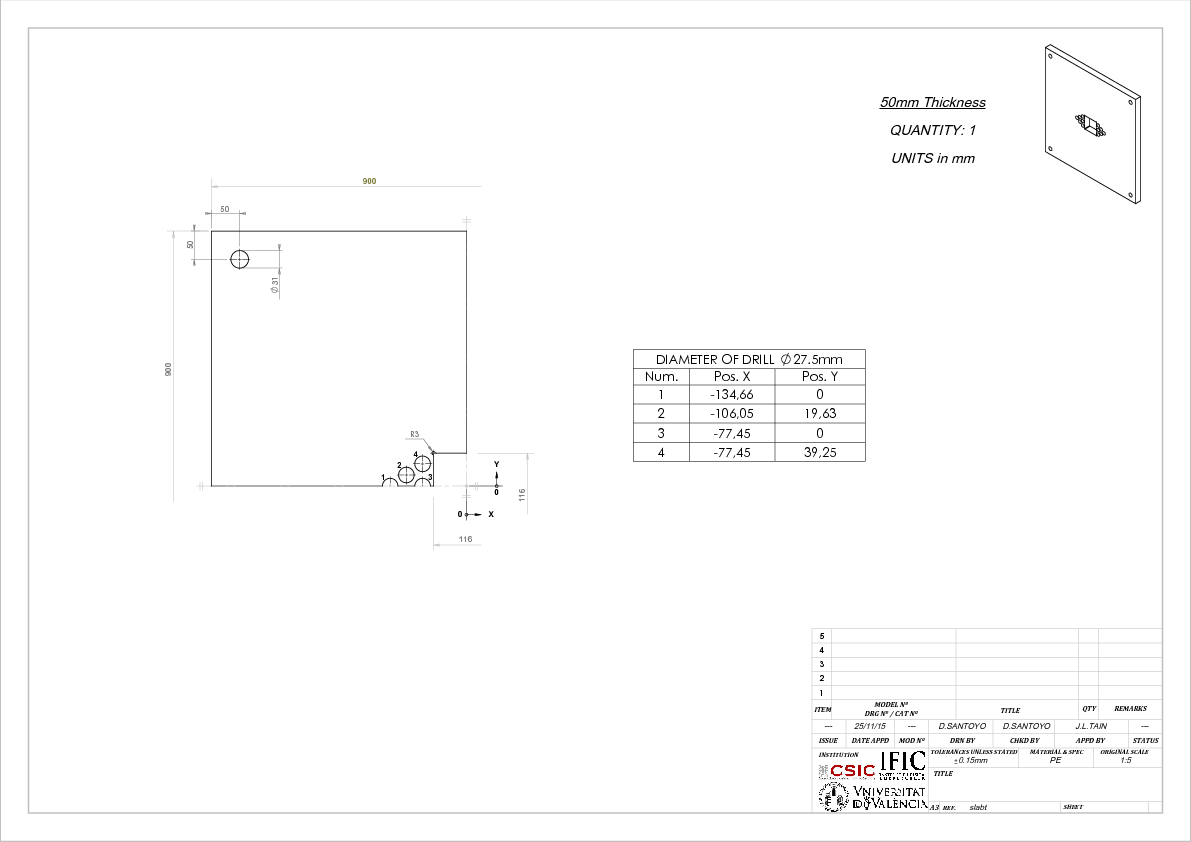

|